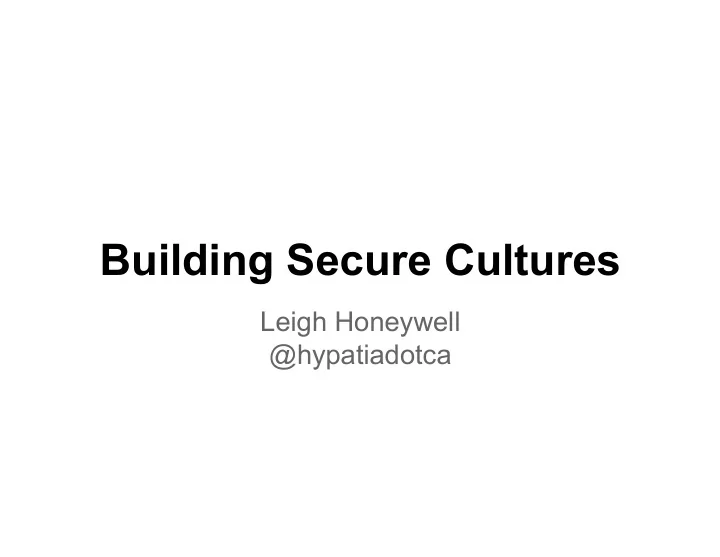

Building Secure Cultures Leigh Honeywell @hypatiadotca
about me Canadian ex-Symantec, Microsoft Rebooted your Windows machines a few times in 2012 Now at Heroku, a Salesforce.com company
move fast and break things….
until this happens
red flags ● “blameful” interactions between security + engineering ● disconnect between severity of security findings and what gets fixed ● long lag between engineering changes and policy changes
green flags Some signs you have a healthy security culture: ● devs reach out to the security team when stuck or unsure ● devs find security bugs in eachothers’ code ● people self-report security issues (cred leaks etc.)
how do you get to green?
transparency + accountability = trust
transparency
accountability
trust
“impacting and influencing” in a breach situation it’s rarely the CEO who gets fired
feigned surprise “The first rule means you shouldn't act surprised when people say they don't know something. This applies to both technical things ("What?! I can't believe you don't know what the stack is!") and non-technical things ("You don't know who RMS is?!"). Feigning surprise has absolutely no social or educational benefit: When people feign surprise, it's usually to make them feel better about themselves and others feel worse. And even when that's not the intention, it's almost always the effect. As you've probably already guessed, this rule is tightly coupled to our belief in the importance of people feeling comfortable saying "I don't know" and "I don't understand."” https://www.hackerschool.com/manual#sub-sec-social-rules
secure development
microsoft.com/sdl
minimum viable SDL ● self-assessment to determine if a project needs security team review or not ● up-front threat modeling that is kept up to date as things evolve ● security review checklist o stay tuned on this one
extra credit ● security tooling in your CI process o codeclimate o ??? others o there is a huge gap in the market here
bug bounty
bug bounty problems ● lots of work in progress with external inputs and dependencies ● emotional labour involved in negotiating severity and reproducibility of bugs ● initially, a lot of low-hanging fruit - which tapers off as you fix stuff
pre-bug-bounty checklist ● communicate the importance of prioritizing bounty bugs ● establish a weekly time bounty work session: o ping bounty work items o communicate with external researchers o review bugs for things that need adding to your SDL
security through play ctftime.org all you need is a google doc and an irc/hipchat/ slack room https://speakerdeck.com/hypatia/ctf-for-mortals
thanks and links Thanks to Jacob Kaplan-Moss and Owen Jacobson for reviewing this deck, and to everyone who’s listened to me babble about security and emotional labour over the past few weeks. http://hypatia.ca will have this deck later today leigh@hypatia.ca / @hypatiadotca
Recommend
More recommend